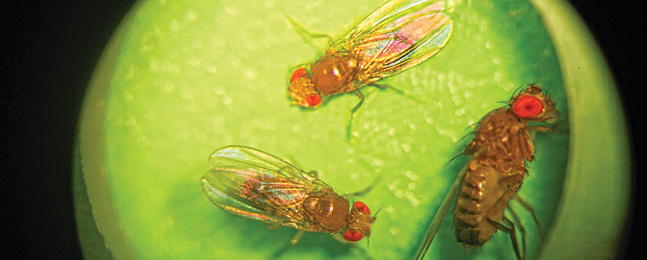Drowsy Drosophila Offer Clues to Overeating

Mike Lovett
by Leah Burrows
Why does gnawing hunger keep us awake, while a full belly makes us nod off? Why do insomniacs often binge eat during the wee hours? What can sleep patterns tell us about obesity?
While scientists have long known that sleep, hunger and metabolism are closely related, they have struggled to understand how these functions interact in humans.
But a recent Brandeis discovery promises to shed light on the complex relationship between sleeping and eating. Scientists in biologist Leslie Griffith’s lab, in collaboration with professor Michael Rosbash and his group, reported in the scientific journal Neuron that sNPF, a neuropeptide that regulates food intake and metabolism, is also an important part of the machinery that promotes sleep in the fruit fly Drosophila.
Neurons use neuropeptides to modify a range of brain functions, including learning, metabolism, memory and social behaviors. In humans, neuropeptide Y, which functions similarly to sNPF, has been studied as a possible drug target for treating obesity.
When researchers in Griffith’s lab amped up sNPF release in fruit flies, the insects fell asleep almost immediately, awaking only to nosh before dozing off again. In fact, once they found a food source, they slept right on top of it for days, stirring only to take a few nourishing nibbles before falling back to sleep.
When researchers restored normal levels of sNPF, the flies resumed their characteristic buzz of activity. The researchers concluded sNPF plays an important regulatory function in sleep in addition to its role in coordinating such activities as eating and metabolism.
“Understanding how the brain chooses between competing drives, like hunger and sleep, is a very difficult problem that has significant implications for human health,” says Griffith.
Scientists still don’t fully understand how regulating neuropeptide function at specific times and in specific cells affects sleeping and eating. The next step in studying sNPF in fruit flies is to learn which cells, neurotransmitters and genes are involved in eating and sleeping; what processes activate and inhibit the behaviors; and how the hunger drive influences the sleep cells.
Safe to say Griffith and her team will not be sleeping on it.
